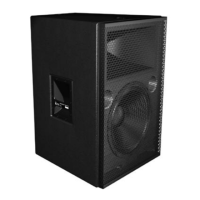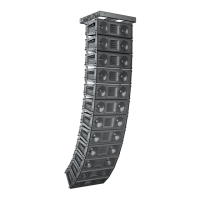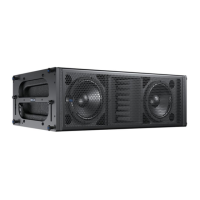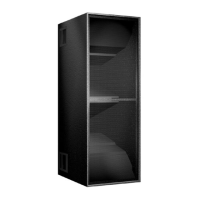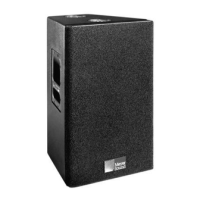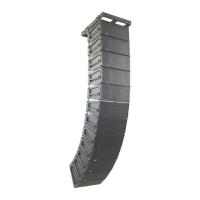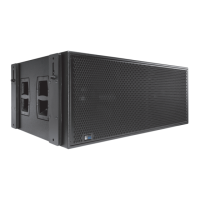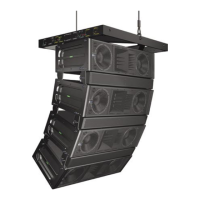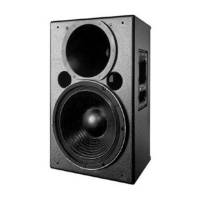CHAPTER 2: POWER REQUIREMENTS
12
CAL VOLTAGE REQUIREMENTS
CAL operates as intended when the AC voltage stays within
the rated voltage range of 100–240 V AC ± 10% at
50–60 Hz.
If the voltage drops below 90 V, CAL uses stored power to
continue operating temporarily; the power supply turns off if
the voltage does not return to normal levels.
If the voltage rises above 264 V, the CAL power supply
immediately turns off to prevent damage to the unit.
If CAL turns off due to either low or high voltage, its power
supply automatically turns on again after 3 seconds, so long
as the voltage has returned to normal levels. If CAL does not
turn back on after 10 seconds, remove AC power
immediately and contact Meyer Sound Technical Support.
CAUTION: The power source for CAL should
always operate within the required voltage
range, at least a few volts from the upper and lower
ranges. This will ensure that AC voltage variations
from the service entry—or peak voltage drops due to
cable runs—will not cause the loudspeaker’s
amplifiers to cycle on and off or cause damage to the
power supply.
NOTE: When voltage fluctuates within CAL’s
rated voltage range, automatic tap selection
stabilizes the operating voltage. This tap selection is
instantaneous with no audible artifacts.
NOTE: Because CAL does not require a
dedicated neutral line, and it can tolerate
elevated voltages from the ground line, it can
be connected to line-line terminals in 120 V, 3-phase
Wye systems. This results in 208 V AC between lines
(nominal) and therefore draws less current than when
using 120 V AC (line-neutral). Make sure that the
voltage remains within CAL’s recommended
operating window (100–240 V AC ± 10%). The
ground line must always be used for safety reasons
and the line-to-ground voltage should never exceed
264 V AC (typically 120 V AC from line-to-ground).
POWERING ON CAL LOUDSPEAKERS
When AC power is applied to CAL, its Intelligent AC™
power supply automatically selects the correct operating
voltage, allowing it to be used internationally without
manually setting voltage switches. In addition, Intelligent AC
provides soft-start power on (eliminating high inrush
currents), suppresses high-voltage transients up to several
kilovolts, filters common mode and differential mode radio
frequencies (EMI), and sustains operation temporarily during
low-voltage periods.
When powering on CAL, the following startup events occur
over several seconds:
1. Audio output is muted.
2. Voltage is detected and the power supply mode is
automatically adjusted as necessary. The power supply
ramps up.
3. After the power on sequence and system check have
completed, the audio output is unmuted, the ON/Status
LED turns solid green, indicating the loudspeaker is
ready to reproduce audio.
CAUTION: If the ON/Status LED does not turn
solid green after powering on and audio is
muted, the loudspeaker has encountered a failure
and may need to be serviced. Contact Meyer Sound
Technical Support.
CAL CURRENT REQUIREMENTS
The current draw for CAL is dynamic and fluctuates as
operating levels change. Because different cables and
circuit breakers heat up at varying rates, it is important to
understand the following types of current ratings and how
they affect circuit breaker and cable specifications.
• Idle Current — The maximum rms current during idle
periods.
• Maximum Long-Term Continuous Current — The
maximum rms current during a period of at least 10
seconds. The Maximum Long-Term Continuous Current
is used to calculate temperature increases for cables
and to ensure that cable sizes and gauges conform to
electrical code standards. The current rating is also
used as a rating for slow-reacting thermal breakers.
• Burst Current — The maximum rms current during a
period of around one second. The Burst Current is used
as a rating for magnetic breakers. It is also used for
calculating the peak voltage drop in long AC cable runs
according to the following formula:
V pk (drop) = I pk x R (cable total)
3-Phase Wye System
Neutral
Earth/Ground
Loudspeaker
(208 V AC)
Loudspeaker
(208 V AC)
Loudspeaker
(208 V AC)
Line 1 (120 V AC)
Line 3 (120 V AC)
Line 2 (120 V AC)

